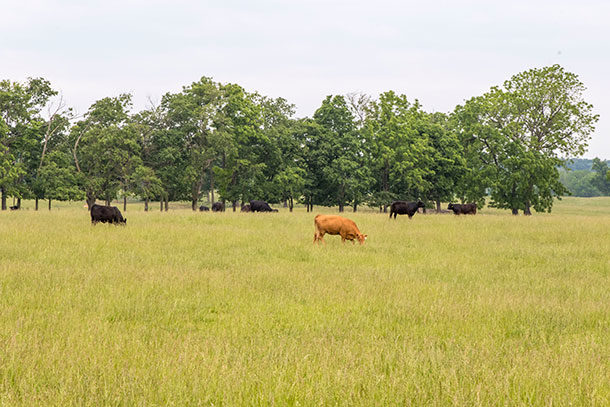When managing grazing livestock, matching forage production potential and animal intake seems to be often overlooked or incorrectly assumed. When I drive by a ranch in the first week of June and pastures are grazed as tight as putting greens, I know the forage system will soon fail.
Failure does not mean nothing is growing. Rather, the production potential will be greatly reduced, weed encroachment will occur and, more importantly, livestock will not obtain their genetic performance potential due to limited forage.
Pasture or range forage production is often not known by livestock managers. The Web Soil Survey tool developed by the Natural Resource Conservation Service (NRCS) can provide an estimate of soil productivity ratings. Soil types in Kentucky, for example, typically have a rating of 5-9 animal unit months (AUM). An AUM defined by NRCS is based on providing 30 pounds of air-dry forage (assume 90% dry matter) per cow-calf pair for a month. Therefore, the greater the AUM rating, the more productive a soil is expected to be. A soil with an AUM rating of 8 would produce approximately 8,000 pounds of dry matter consumed per acre over the growing season, under the assumptions defined above.
To contrast this, the range production potential just outside Albuquerque, New Mexico, may only be 400-600 pounds annually. This is total vegetative production, including grasses, shrubs, woody plants and other vegetation cattle would not consume. The land base needed to support a cow-calf pair in Kentucky during grazing season may be two acres, whereas in New Mexico, it could be near 50-70 acres, in a normal year. Toss in a mega drought, and stocking rates have had to be reduced significantly for the last couple of decades in the southwest. Stocking rates vary by region of the country but also by soil type and precipitation received. We cannot always rely on precipitation to fall evenly over the growing season, which further complicates managing grazing systems.
As livestock managers, it can be difficult to consider managing the number of cattle grazing forages with ever-changing growing conditions. In a region with adequate precipitation, the norm for beef cow-calf producers is to manage a similar number of cows year in, year out. During periods of reduced precipitation, livestock systems stocked based on early spring forage production levels will result in overgrazing and be detrimental to forage persistency. On top of this, supplemental feeding is often delayed too long hoping for rain, which can lead to grazing out of the desirable forages, as well as impacting animal productivity.
During periods of greater input costs, returns are likely to be improved by reducing stocking rates. Slightly reducing stocking rates, combined with a simple rotational grazing system, will improve plant persistency and productivity. Excess forage in late spring can be stockpiled for summer grazing, when forage growth begins to slow. Areas of pasture can be set aside in late summer for stockpiling for grazing in the early winter. Rotational grazing will reduce selectivity, leading to improved forage utilization. Moving cattle to different pastures will provide plants a rest period, allowing development of new above-ground biomass and enhancing root-system development. Improving forage persistency will increase competitiveness with undesirable plants, reducing weed populations. Improved forage utilization and persistency of desirable forages can lead to reduced reliance on purchased or stored forages, lowering input costs.
Consider developing a grazing system that allows for animal numbers to be reduced easily when forage growth slows and/or is limited. Examples may include holding fall-born weaned calves through the spring flush and selling in early June for cool-season pasture systems. Reducing breeding females and adding a custom grazing-stocker program can be another option to build flexibility into grazing systems. Retaining more replacement heifers than needed is an easy way to implement a stocker program. Maintaining fences around crop fields to take advantage of crop residues can extend grazing days. As grain commodity prices continue to remain high, look for areas in your forage program and grazing system that will allow you to reduce purchased-feed inputs.
The winter months are a great time to evaluate your grazing system. Consider your carrying capacity and whether the stocking rate allows for an economically and environmentally sustainable grazing system. Implement a record system to evaluate grazing areas for forage biomass, weed encroachment, days grazed, days rested and additional information to better manage your grazing system. The old saying, “You can’t manage what you don’t measure,” holds true with your grazing system. I encourage you to visit with your local NRCS staff or county extension agent to discuss your grazing plan and goals.









